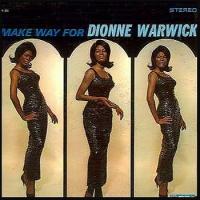Classic Dionne Warwick Album Reissued on CD By Collector's Choice
Bacharach and David walked a fine line between brilliance and kitsch during their collaborations with Dionne Warwick, creating for her a musical persona that was the original “desperate housewife,” though of a much more helpless and vulnerable variety.
The music was chandelier-grand, with swooping strings, rumbling tympani, vibrato-drenched background singers and lurching, melodramatic rhythms. In other words the perfect accompaniment to Hal David’s almost voyeuristic look into the hearts and minds of lonely, single (or married) suburban mid-sixties women. Yet the classic “Walk On By” was a big hit on the 1964 pop charts, and seemed to fit right into the rougher rock mix.
This album, issued in 1964, contains a strong selection of Bacharach/David classics, including “Walk on By,” “They Long To Be Close To You” (successfully covered by The Carpenters), “You’ll Never Get To “Heaven,” “A House Is Not a Home,” and “Wishin’ And Hopin’” popularized by Dusty Springfield.
Both that song and “I Smiled Yesterday” (with an oboe lead! And an odd “glitch” that's timed to sound like the stylus sticking in the grooves) appeared on Presenting Dionne Warwick,” the singer’s Scepter debut, so perhaps this album was rushed out to coincide with the success of “Walk on By” not that it matters because this is arguably Warwick’s strongest Bacharach/David produced Scepter album.
Be forewarned though: it also includes an ill-advised cover of “People,” and takes a diversion to teeny-bopper land with the wildly out of place and primitive, “electronically processed for stereo” sounding “Get Rid of Him,” and Goffin/King’s melodramatic “Make The Night A Little Bit Longer.”
If I ran a vinyl reissue label, Make Way… would be among my first choices for both the classic song writing, arranging and performing and for the brilliant A&R Studio, Phil Ramone-engineered sound. Whether you consider the music exceptional, or as over the top, cringe-inducing kitsch, it makes for great music-making and listening on every level, as well as a window onto the brilliance and excitement of the early ‘60’s studio scene.
No doubt this was recorded live to four track, or perhaps even directly to two. So when you hear the complexity of “Walk On By,” with its string section, tympani, trumpet, electric guitar and background singers and hear how Ramone records and mixes the song’s bridge on the fly, it should leave you slack jawedespecially if your only memory of the song is as a monophonic single played on your car’s AM radio.
“Walk On By” is a sonic stunner, as is much of this album, though the perspective is obviously skewed towards Warwick’s vocals and she appears huge between the speakers, sometimes shrilly so, and the mix is mostly hard left/right and center.
Criticizing tonal balance should be done with care: every system is different and unless something’s way out of whack, it’s important to not be a stinking navel gazing audiophile and declare something that doesn’t sound good on one particular system (namely mine or your version of sonic “perfection”) as a disaster, or whatever.
That said, it was encouraging to hear tape hiss on the opening track of this CD reissue because it meant that mastering engineer Bob Fisher didn’t attempt to “clean up” the recording by attenuating the hiss and loping off the top end air and brilliance in the process.
However, once Warwick’s voice chimed in the occasional shrillness heard on the record turned into an unrelenting glare, forcing me to turn the overall volume down lower than where I’m used to when listening to this on vinyl.
It’s as if the mastering engineer decided to bring Warwick’s voice forward in the mix by boosting the presence region. Way forward. The move brightens and hardens everything in its path and destroys suppleness and believability. When Warwick sings the word “goodbye” on “Walk on By,” she holds the word and modulates the volume. On the record when she projects, there’s emphasis and realism. On the CD she’s stabbing you.
If you turn the volume down it becomes far more listenable, but when the particular region that’s boosted gets excited the music can still leap out and bite you on the ear. Too bad because this could have been so much better. Or, if your system is deficient in that region, it will sound just swell.
If you’re looking for an original Scepter vinyl copy (do), go for a silver/black/white/grey/red label edition (Scepter S 523) and make sure it’s got the “Bell Sound” stamp on the lead out groove area and not the Columbia stamped number matrix. If you find a clean one, it will sound stupendous, especially side two and “Walk on By” in particular and if your arm/cartridge can handle the bell trees and triangle on “You’ll Never Get To Heaven” cleanly and without smear or break-up, its tracking effectively.
All of the CDs in this series (including Presenting...,Anyone Who Had a Heart and The Sensitive Sound of... and others) seem to be equalized with the same forward presence sound, but I’d still recommend this one if you don’t have a turntable. The music epitomizes a period of time in America in which great cultural change was occurring but a few more years would have to pass before the plates would shift.
Please read the Burt Bacharach interview I conducted with him back in 1986:



